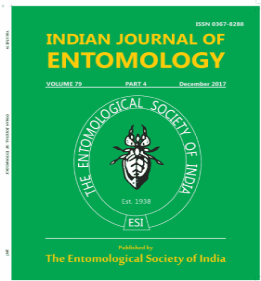Impact of Essential Oils on Biological Traits of Trichogramma chilonis Ishii
DOI:
https://doi.org/10.55446/IJE.2023.1521Keywords:
Corcyra cephalonica, essential oils, IPM, Ocimum basilicum, parasitoids, Piper betle, selectivity, Trachyspermum ammi, Trichogramma chilonis, TrichogrammatidaeAbstract
Trichogramma chilonis Ishii (Hymenoptera: Trichogrammatidae) reared on factious host rice moth Corcyra cephalonica (Stainton) (Lepidoptera: Pyralidae) is an egg parasitoid on lepidopteran pests. The essential oils, viz., ajowan Trachyspermum ammi, betel Piper betle, and sweet basil Ocimum basilicum and neem oil were assessed for their toxicity and biological traits like parasitism and emergence on T. chilonis. Among the EOs tested, T. ammi caused highest toxicity to T. chilonis (LC50 0.316 ppm) followed by P. betle (LC50 0.567 ppm). At sublethal dose, they had an impact on parasitism and adult emergence of T. chilonis. Whilst O. basilicum and neem oil were relatively safe at sublethal doses to T. chilonis. This study highlights the need to maintain a waiting period before the release of T. chilonis in EOs treated substrates.
Downloads
Metrics
Downloads
Published
How to Cite
Issue
Section
References
Adarkwah C, Nyarko G, Opoku N, Badii B K, Addai I K, Prozell S, Ulrichs C, Scholler M. 2015. Effectiveness of the egg parasitoid Trichogramma evanescens preventing rice moth from infesting stored bagged commodities. Journal of Stored Products Research 61: 102-107.
Bibiano C S, Alves D S, Freire B C, Bertolucci S K V, Carvalho G A. 2022. Toxicity of essential oils and pure compounds of Lamiaceae species against Spodoptera frugiperda (Lepidoptera: Noctuidae) and their safety for the non-target organism Trichogramma pretiosum (Hymenoptera: Trichogrammatidae). Crop Protection 158: 106011.
Castilhos R V, Grutzmacher A D, Coats J R. 2018. Acute toxicity and sublethal effects of terpenoids and essential oils on the predator Chrysoperla externa (Neuroptera: Chrysopidae). Neotropical entomology 47: 311-317.
Chaudhari A K, Singh V K, Kedia A, Das S, Dubey N K. 2021. Essential oils and their bioactive compounds as eco-friendly novel green pesticides for management of storage insect pests: prospects and retrospects. Environmental Science and Pollution Research 28: 18918-18940.
Chintalchere J M, Dar M A, Raut K D, Pandit R S. 2021. Bioefficacy of lemongrass and tea tree essential oils against house fly, Musca domestica. Proceedings of the National Academy of Sciences, India Section B: Biological Sciences 91(2): 307-318.
Cruz R A D L, Parreira D S, Dimate F A R, Batista L D, Ribeiro R C, Zanuncio J C. 2021. Effects of essential oils on biological attributes of Trichogramma galloi adults.Journal of Asia-Pacific Entomology 24: 64-67.
Dupatne P, Venkatesan T, Navik O, Mohan M, Venugopal K M, Basavaarya, Linga V, Lalitha Y, Sivakumar G, Ashwini M. 2023. Cross-resistance and biochemical mechanism in an insecticide-resistant population of Trichogramma chilonis Ishii (Hymenoptera: Trichogrammatidae) and its parasitizing efficiency against invasive fall armyworm Spodoptera frugiperda. Current Science 124(1): 115-122.
Finney D J. 1947. Probit analysis, 3rd (eds.). Cambridge University Press, Cambridge.
Giunti G, Benelli G, Palmeri V, Laudani F, Ricupero M, Ricciardi R, Maggai F, Lucci A, Guedes R N C, Desneux N, Campolo O. 2022. Non-target effects of essential oil-based biopesticides for crop protection: Impact on natural enemies, pollinators, and soil invertebrates. Biological Control 176: 105071.
Gonzalez J O W, Gutierrez M M, Ferrero A A, Band B F. 2014. Essential oils nano formulations for stored-product pest control-characterization and biological properties. Chemosphere 100: 130-138.
Isman M B. 2019. Commercial development of plant essential oils and their constituents as active ingredients in bioinsecticides. Phytochemistry Reviews 19: 235-241.
Lalitha Y, Ballal C R. 2015. Influence of seasons and inoculum dosages on the production efficiency of Corcyra cephalonica (Stainton). Journal of Biological Control 29(1): 25-30.
Meena B L, Jeengar K L, Singh B, Meena N L. 2016. Evaluation of different plant powders as seed protectants against rice moth, Corcyra cephalonica (Stainton). Journal of Applied and Natural Science 8(2): 910-918.
Oudenhove L V, Cazier A, Fillaud M, Lavoir A, Fatnassi H, Perez G, Calcagno V. 2023. Non-target effects of ten essential oils on the egg parasitoid Trichogramma evanescens. Peer Community Journal. doi.10.24072/pcjournal.212.
Parreira D S, Cruz R A L, Dimate F A R, Batista L D, Ribeiro R C, Ferreira G A R, Zanuncio J C. 2019. Bioactivity of ten essential oils on the biological parameters of Trichogramma pretiosum (Hymenoptera: Trichogrammatidae) adults. Industrial Crops and Products 127: 11-15.
Parreira D S, Cruz R A L, Leite G L D, Ramalho F D S, Zanuncio J C, Serrao J E. 2018b. Quantifying the harmful potential of ten essential oils on immature Trichogramma pretiosum stages. Chemosphere 199: 670-675.
Parreira D S, Cruz R A L, Zanuncio J C, Lemes P G, Rolim G D S, Barbosa L R, Leite G L D, Serrao J E. 2018a. Essential oils cause detrimental effects on biological parameters of Trichogramma galloi immatures. Journal of Pest Science 91: 887-895.
Poorjavad N, Goldansaz S H, Dadpour H, Khajehali J. 2014. Effect of Ferula assafoetida essential oil on some biological and behavioral traits of Trichogramma embryophagum and Trichogramma evanescens. Biocontrol 59: 403-413.
Raguraman S, Singh R P. 1999. Biological effects of neem (Azadirachta indica) seed oil on an egg parasitoid, Trichogramma chilonis.Journal of Economic Entomology 92(6): 1274-1280.
Rajak P, Roy S, Ganguly A, Mandi M, Dutta A, Das K, Nanda S, Ghanty S, Biswas G. 2023. Agricultural pesticides–friends or foes to biosphere?.Journal of Hazardous Materials Advances 10: 100264.
Rajasekhar L, Lavanya N, Divya J. 2016. Estimation of production potential of host insect Corcyra cephalonica (Stainton) (Lepidoptera: Pyralidae) on different diet combinations to produce Trichogramma chilonis. International Journal of Plant Animal and Environmental Science 6(2): 77-80.
Ray A, Gadratagi B G, Budhlakoti N, Rana D K, Adak T, Govindharaj G P P, Patil N B, Mahendiran A, Rath P C. 2023. Functional response of an egg parasitoid, Trichogramma chilonis Ishii to sublethal imidacloprid exposure. Pest Management Science. doi. 10.1002/ps.7540.
Siviter H, Muth F. 2020. Do novel insecticides pose a threat to beneficial insects. Proceedings of the Royal Society B: Biological Sciences 287(1935): 20201265.
Sombra K E S, Pastori P L, Aguiar C V S D, Andre T P P, Oliveira S J D, Barbosa M G, Pratissoli D. 2022. Selectivity of essential oils to the egg parasitoid Trichogramma pretiosum Riley (Hymenoptera: Trichogrammatidae). Revista Ciencia Agronomica. doi.10.5935/1806-6690.20220022.
Souza B, Vazquez L, Marucci R. Natural enemies of insect pests in neotropical agroecosystems: Biological Control and Functional Biodiversity. Springer, New York. 535 pp.
Carvalho G A, Grutzmacher A D, Passos L C, Oliveira R L D. 2019. Physiological and ecological selectivity of pesticides for natural enemies of insects. pp. 469-478.
Sowmya M, Bindu O S, Subaharan K, Kumar T M, Senthoorraja R, Varshney R, Rao N B V C. 2023. Toxicity, ovipositional behavioural and electrophysiological response of rice moth, Corcyra cephalonica (Stainton) adults to essential oils. Indian Journal of Entomology. doi. 10.55446/IJE.2023.1198.















